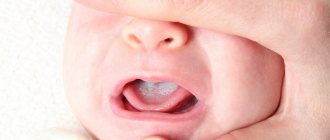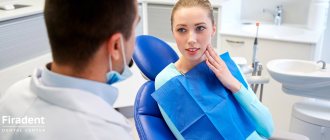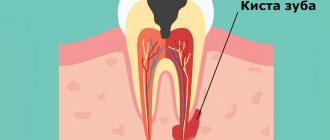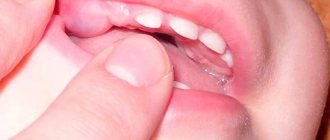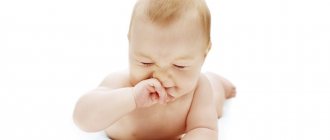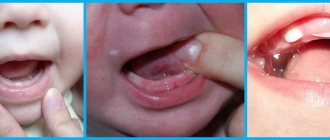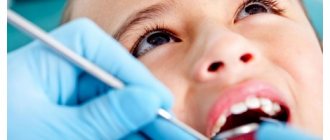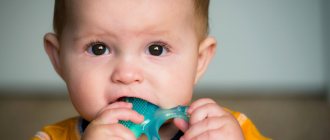Teething in infants and older children is no different: the gums swell, a white spot appears, a tooth emerges, followed by a second one (they appear in pairs).
The only difference is that older children can tell where it hurts and what is wrong, but infants need to be constantly monitored in order to quickly detect approaching teeth and help them grow calmly.
In this article we will talk about the procedure for teething in infants, the main symptoms and ways to make this process more relaxed.
How babies teeth cut: timing and development factors
The foundation of baby and permanent teeth is laid during pregnancy: their health is directly affected by the lifestyle and health of the mother.
After the birth of a child, minerals accumulate in his body, which will become building materials for teeth. The first of them appears when the baby is six months old - this happens in most situations.
But there are many cases where a child was born with a pair of ready-made teeth, or vice versa, when teeth appeared after the first year of life. This is normal: the process is influenced by many factors - from food to place of residence, when exactly teeth are cut.
In total, nature plans 20 milk teeth. They appear in pairs, so teething in infants is usually divided into 10 stages:
- First (medial) lower incisors - 6-10 months.
- First (medial) upper incisors - 8-12 months.
- Second (lateral) upper incisors - 9-13 months.
- Second (lateral) lower incisors - 10-16 months.
- First upper molars - 13-19 months.
- First lower molars - 14-18 months.
- Upper canines - 16-22 months.
- Lower canines - 17-23 months.
- Second lower molars - 23-31 months.
- Second upper molars - 23-31 months.
From 3 to 6 years old, a temporary bite forms in the child’s mouth: it changes when the baby teeth begin to fall out. A temporary bite has a huge impact on a permanent one, and a person’s smile, which will be with him all his life, depends on its correctness.
Along with 20 milk teeth, the roots of 16 permanent teeth appear. The rest grow up at a later age.
We emphasize once again that deviations from the schedule are normal, even within a few months. To be sure, consult your pediatric dentist.
Baby's red cheeks: should I worry?
Children's skin is incredibly sensitive to both environmental influences and the child's general well-being. Therefore, in some cases, red cheeks are a reason to think about the baby’s health.
Response to environmental influences
Red spots on a child's cheeks may be a banal reaction to cold or heat. The process of heat exchange in infants does not proceed the same way as in adults, so red cheeks can signal overheating or, conversely, too close contact with frost. In the first case, the baby must be immediately cooled, and in the second, apply protective cream to exposed skin 20 minutes before going outside.
Manifestation of allergies
Have your baby’s cheeks turned red, started to peel and even itch? This may be a manifestation of an allergy - food, household chemicals, dust or animals. Often the redness of the cheeks in this case is also accompanied by the appearance of redness in the area of the shoulders, forearms and groin. Be sure to consult a doctor to find out why your child has red cheeks and to eliminate the allergen from the environment that causes such a reaction in the baby.
Atopic dermatitis
Babies suffering from atopic dermatitis often experience redness, which is accompanied by severe dryness, itching and even crusts. As a rule, there are pockets of dermatitis on other parts of the body, and dryness and redness do not go away with the use of conventional moisturizing creams. Atopic dermatitis is a serious reason to see a doctor.
Enzyme deficiency
Enzyme deficiency usually manifests itself in children in the first year of life. One of its symptoms is redness of the baby’s cheeks (in this case, the child may not gain weight). When a baby eats more than his body can absorb, the unprocessed protein causes an allergic reaction and, as a result, reddening of the cheeks. In this case, you should carefully monitor the amount of food offered to the child, especially when artificial feeding.
Teeth cutting
Redness of the cheeks and swelling of the gums are sure signs that a new tooth will soon appear. At this time, the baby’s behavior may also change: he rubs his ears and cheeks, becomes irritable, and sleeps restlessly. You can alleviate the baby’s condition with special teethers or a soothing gel (as prescribed by a doctor).
Viral or infectious diseases
Red spots on a child’s cheeks are far from the only symptom that parents should pay attention to. For example, with ARVI this can be a fever, cough and runny nose, and with infantile roseola - loose stools, fever and a rash (first on the cheeks, and later throughout the body from the face to the feet). Red cheeks combined with pale lips and the tip of the nose can also be a sign of pneumonia. In all these cases, it is necessary to contact your pediatrician as soon as possible.
Everything is fine!
The most common cause of red cheeks in a child is an allergic reaction. But it is quite possible that the child simply spent an active day, moved and laughed a lot, or took a long walk in the fresh air. Such a blush is a joy for the mother and a sign of the baby’s excellent health!
Signs of teething in infants
The only primary sign of the appearance of the first teeth is the appearance of a white spot on the gum (transparent through the thin skin of the enamel).
The remaining signs can be considered secondary - they are not always symptoms of teething:
- Poor sleep, appetite, mood.
- Red hot cheeks.
- Pain in the nose and ears, runny nose, sore throat.
- Increased salivation (sometimes this causes vomiting - the child constantly swallows his saliva).
- Fluid blisters and redness on the gums.
In some cases, a soft ball of liquid (pink or slightly bluish) may appear on the gum where the first teeth appear. This is a common occurrence, but if the lump has become very large and is bothering the child, you should consult a dentist.
Important:
fever, vomiting, and diarrhea are not consequences of teething in infants. They may be the result of certain symptoms (for example, vomiting due to excessive swallowing of saliva). But in most cases, the cause is other diseases that require treatment. If your child is teething and this is accompanied by fever, nausea, or abdominal pain, you should consult a doctor.
Causes
Swelling of the cheek can occur for various reasons, the main ones:
- mechanical injury or bruise;
- development of dental diseases;
- a bite of an insect;
- if the swelling is accompanied by pain in the ear, then we can talk about an inflammatory process in the ear canal;
- redness of the cheek may be a symptom of an allergic reaction;
- If it becomes difficult for a child to breathe, you need to immediately call an ambulance; it could be Quincke's edema.
Since we are talking about a baby, there is no need to guess and find out the cause; you need to see a doctor or call an ambulance as quickly as possible.
A swollen cheek can be a symptom of various dental diseases:
- Deep caries. Symptoms: pain, swelling of not only the cheeks, but also the gums.
- Pulpitis. Symptoms: severe aching pain, bad breath.
- Periodontitis. The main symptom, in addition to swelling of the cheek, is pain while eating.
- Periostitis (flux). Symptoms: pain, swelling of the gums, high body temperature.
Pain and swelling of the cheek can also develop as a result of the following reasons:
- Removal of a tooth. After the procedure, swelling may persist for the first couple of days.
- Orthodontic treatment. Installed braces may cause slight swelling of the cheek.
- Treatment of pulpitis. Improper canal filling can lead to pain after treatment and an enlarged cheek.
- Teething. The appearance of teeth may be accompanied by slight swelling not only of the gums, but also of the cheeks.
An enlarged cheek does not always indicate problems with teeth or gums; there are other factors and diseases that can cause a similar condition:
- Sinusitis is an inflammatory process of the nasal mucosa. In this case, nasal congestion and difficulty breathing are observed.
- Lymphadenitis is inflammation of the lymph nodes. Manifested by enlarged lymph nodes.
- A cyst is the formation of a small lump in the oral cavity.
- Impaired kidney function can be accompanied by swelling of various parts of the body, including the cheeks.
- Facial neuritis. Swelling occurs due to pressure on the nerve.
All of these diseases require immediate help and treatment.
If the cause is injury or bruise, swelling should be accompanied by a hematoma. In this case, the damage most likely occurred due to biting the mucous membrane or due to careless handling of the brush while brushing the teeth.
If a hematoma is not observed, the injury may be the result of an incorrect bite or poorly installed fillings that injure the oral mucosa.
A severe burn due to eating too hot food can also cause cheek enlargement.
How to help a child?
It is impossible to speed up the process of teeth appearing - sometimes it drags on for weeks (for one tooth). The maximum that parents can do is to reduce the number of unpleasant symptoms.
- Vibucol suppositories can be used as a sedative.
- As a pain reliever - children's versions of Nurofen and Panadol.
- As a hygiene product for the oral cavity - gel-based anti-inflammatory toothpastes for children from 0 years old. Asepta Baby paste is designed for little ones. It does not contain fluorides, parabens, or abrasives. Gently cleans teeth, saturating them with calcium. The paste tastes good and is safe - if the child wants, he can swallow it without harm.
Read more about ways to help your baby during teething in other articles in this section.
Examination of erupted teeth
Swelling and redness of the gums gradually disappear as the baby’s teeth erupt and grow, but require observation. Normally, teeth should be evenly positioned in the dentition, without whitish or colored spots, or unevenness in the enamel.
Violation of the timing, pairing and sequence of eruption of primary teeth can serve as a marker of various diseases and disorders. For example, rickets or hypothyroidism [2]. It is important to record the date of appearance of each tooth and its location in the mouth. This is convenient to do using photos saved in a separate folder on your smartphone.
How can you prevent tooth rashes from appearing?
Here are some tips to help avoid dental rashes:
- Wipe drool gently and frequently with a soft cloth to remove the irritant.
- Stock up on soft bibs that will stop drooling.
- Change clothes wet from drool to dry ones.
- Use petroleum jelly or a healing baby ointment containing petroleum jelly (for example, Aquaphor), which will create a barrier to protect the skin from drooling.
Dr. Jones assures that getting a small amount of ointment on a child's lips is harmless.
You can also use lanolin ointment.
Or maybe this rash is not on the teeth?
The rash can be caused by a variety of viruses and is usually associated with fever.
According to the American Academy of Pediatrics, teething may be accompanied by a slight increase in body temperature (below 38C), but this is not considered fever, which is characteristic of viruses.
Red, puffy patches may also be eczema, known as atopic dermatitis. True, most often, unlike a rash on the teeth, eczema appears on the folds (behind the knees and ears, in the inner bends of the elbows and on the hands).
